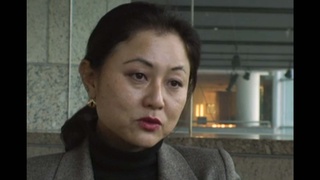Interviews
Outhouses and showers at camp
The only thing that really bothered me were the outhouses. They had outhouses at the end of each barracks. And in order to go, you had to climb these steps. It was like going up on stage to go to the bathroom, (laughs) you know? You couldn’t drink the tap water, so they had barrels of water that they could drink out of. But they not did have latrines. They didn’t have any showers, so you couldn’t take a shower.
I don’t remember how the showers—come to think of it, they must have added the showers later. Yeah, they probably didn’t have showers initially, because I remember when they had that first shower. They had one in Block 1. Everybody went down to Block 1 to take a shower, and it was ice cold. It was just melted snow. (groans, laughs)
And we all went down to Block 1 to take a shower. I don’t know what happened in the interim, between that time, if we didn’t take our shower. We had buckets, so you could wash yourself with a bucket. I don’t know. A lot of that is just erased from my mind. (laughs)
The first few weeks or months are pretty spartan. The whole place was spartan, but the first few weeks (laughs) were really particularly spartan because there just wasn’t much there. The worst things were the outhouses. I guess there were no latrines. Yeah. There were no latrines. That’s right. They didn’t build latrines until they got the sewage systems in. That’s why there were no showers.
Date: June 12, 1998
Location: California, US
Interviewer: Darcie Iki, Mitchell Maki
Contributed by: Watase Media Arts Center, Japanese American National Museum
Explore More Videos

Japanese American railroad workers are fired following the bombing of Pearl Harbor
(b. 1923) Chick sexer

A racist encounter at a movie theater following the bombing of Pearl Harbor
(b. 1923) Chick sexer

Encountering a train full of Japanese Americans being transported to a concentration camp
(b. 1923) Chick sexer


Joined Japanese Imperial Army during the WWII (Spanish)
(b. 1929) Nisei Argentinean


Donating clothes to the Japanese interns (Japanese)
(1900–1996) The mother of Nikkei Brazilian immigration

Relief fund to support Japanese communities (Japanese)
(1900–1996) The mother of Nikkei Brazilian immigration

Role of Assistancia Social dom Jose Gaspar (Japanese)
(1900–1996) The mother of Nikkei Brazilian immigration

Interrogation by police (Japanese)
(1900–1996) The mother of Nikkei Brazilian immigration

Concentration camp from a Japanese mother’s point of view (Japanese)
Shin-Issei from Gifu. Recently received U.S. citizenship

No immediate impact after Pearl Harbor
(b. 1928) Doctor. Former Chair of the Japanese Canadian Redress Foundation.

Treatment of Japanese fishermen in Canada during World War II
(b. 1928) Doctor. Former Chair of the Japanese Canadian Redress Foundation.

Government's permission to publish Japanese newspaper in Canada during World War II
(b. 1928) Doctor. Former Chair of the Japanese Canadian Redress Foundation.

Japanese newspaper supported by Canadian government during World War II
(b. 1928) Doctor. Former Chair of the Japanese Canadian Redress Foundation.
